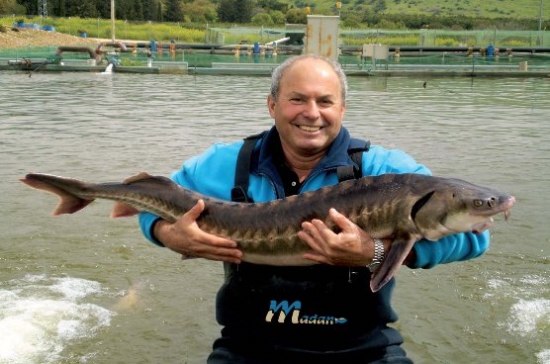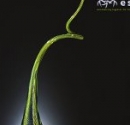
"Caviar comes from the virgin sturgeon,
The virgin sturgeon is a very fine fish,
The virgin sturgeon needs no urging,
That's why caviar is my dish."
The words had been hidden away in my memory for many years and suddenly bubbled to life as we visited the fisheries of Kibbutz Dan in the Upper Galilee with our Slow Food Association members and were introduced to the locally bred sturgeon. Fish breeding there goes right back to the early days of the kibbutz which was formed in 1939. The cool, fresh flowing waters of the Dan river supplied an ideal source for the expansion of ponds for breeding purposes. Throughout the years their perfecting of breeding methods and fish production has become known throughout the world.
The latter years of the 20th century brought a high number of Russian immigrants to Israel with a taste for caviar (or similar but less expensive fish roes) and their interest plus demand for it awoke awareness for marketing possibilities. The fact that the Caspian Sea was proving unable to meet world demand as their sturgeon population dwindled due to over-fishing, water pollution and the destruction of breeding areas added encouragement. With no decline in world demand the prices of caviar were mounting and so it was in 1994 that Dr. Avshalom Horowitz, biologist and kibbutz member, with the support of Professor Levanon, chief scientist of the Ministry of Agriculture, invested in the launching of the Sturgeon Project in Kibbutz Dan.
Traditionally caviar that came from female sturgeon roe was fished only in Russia's Caspian Sea as well as in regions of Iran – these are the Beluga, Osetra and Sevruga varieties which, according to their flavor, size, consistency and color, could reach prices between $5,000 to $6,000 per kilo. It was decided that the Osetra variety would be the most suitable type to produce in the ponds of Dan Fish Farms. Permission was given to import a small number of mainly female sturgeons from Russia and experimentation began. The focus of the project was to learn how to breed and grow the fish artificially in ponds where water had to be kept fresh and below a maximum temperature of 23 degrees centigrade. After that it was a must find a way to speed up the fertility stage and reach profitability. The female produces the eggs required for the production of caviar and the time required for her maturity was successfully reduced from 15 to 7 years.
Today caviar of the highest quality is produced there and exported to the United States, Europe and Japan; it is considered to be as good, if not better, that the original from the Caspian Sea. Farming methods are such that after four years of growth young fish are taken from the water and submitted to a sex test which is carried out by making a small incision in the stomach. Male and female are separated and the females continue to swim the waters and produce their precious eggs for a number of years. At maturity (7 years) the eggs that the female lays, which are about 30,000 per fish per annum, have come about naturally and when judged ready for consumption are carefully taken from the waters and prepared for the market. The sturgeon is a strong fish and with careful farming is not prone to disease; in addition, no hormonal additives are administered during growth, so the caviar is fully organic. A healthy sturgeon in natural conditions could manage to exist for more than 80 years. Male fish, unless required eventually for breeding purposes, are marketed for flesh consumption.
Besides the impressive caviar production, the Dan Fisheries breed delicious rainbow trout and have also entered the eel market, again using their progressive methods of experimentation to produce a high quality fish. However, the eels are bred for export only, whilst the trout have captured local markets with their excellent quality.
Living a few kilometers away from Kibbutz Dan we are able to enjoy our choice of trout which is the big family favorite and it has replaced the use of frozen sides of salmon in our kitchen. Caviar consumption would only be for very special occasions – however it was amazing to view and admire these strong and potent fish cutting through the waters of the pristine ponds and to marvel once again at what our farming experts can achieve.
A change from gefilte fish for a first course at Pesach
Marinated Trout
(serves 6)
600 gram fresh trout skinned and filleted
2 medium size tomatoes
6 – 8 spring onions
Juice of 2 lemons
Half tsp. sea salt, same of crushed chilies
1 heaped tablespoon castor sugar
Fresh coriander
1 dessertspoon finely grated ginger root (optional)
Method:
Cube trout in bite size pieces
Peel and chop tomatoes and add chopped green onions and a handful of chopped coriander.
Place in chilled bowl together with trout.
Pour over lemon juice, add sugar, salt and ginger (if using)
Mix well, cover and allow to marinate in fridge for 24 hours (or longer according to requirement)
Serve on individual plates garnished with hard boiled egg slices, black olives and herbs.
 LEV-RAN SCHOOL: A LOVE STORY (new)
LEV-RAN SCHOOL: A LOVE STORY (new) DEAR EDITOR 154
DEAR EDITOR 154 KNITTING CLUBS: TEL AVIV'S KNITTING & CROCHET SOCIAL CIRCLE
KNITTING CLUBS: TEL AVIV'S KNITTING & CROCHET SOCIAL CIRCLE-1516356428.jpg) Hand in Hand Food Pantry
Hand in Hand Food Pantry Forever Slim
Forever Slim Food Foolish
Food Foolish Barbara Abraham
Barbara Abraham